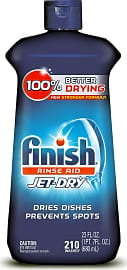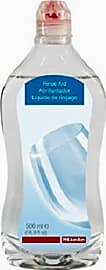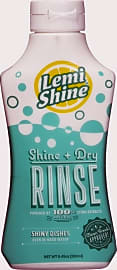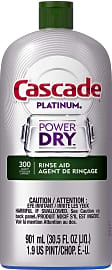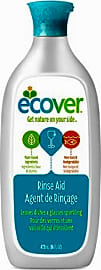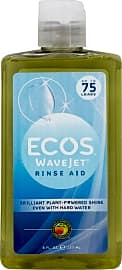The 10 Best Dishwasher Rinse Aids

This wiki has been updated 31 times since it was first published in April of 2018. Even modern dishwashers can leave an unappealing filmy residue and unsightly marks and streaks on dishes, utensils, and glassware. So get your prized plates, silver, and cherished crystal sparkling with one of these rinse aids. We've included potent formulas along with nontoxic, eco-friendly solutions that boost drying power, protect against clouding, and prevent annoying spots. When users buy our independently chosen editorial choices, we may earn commissions to help fund the Wiki.
Editor's Notes
October 23, 2020:
Some people wonder whether they really need a rinse aid and the unpopular answer is it depends. While certain dishwashers are made to function with it as a necessary step to a well-washed load, not everybody has this issue or wants to pay for yet another cleaning product. We can say that options like Cascade Platinum are formulated to work in conjunction with the company's dishwashing tablets, but that's not always the case. A good rule of thumb is, if your dishes are consistently coming out of the wash with bits of food stuck to them or noticeable streaks and water spots, a rinse aid can help. Some people are tempted to make DIY rinse aids at home, which can be effective, but be aware that vinegar, which is popular in these concoctions, can have an adverse effect on your machine over time when used frequently.
We understand that some of the most powerful selections, like the popular Finish Jet-Dry, contain chemicals that make them effective, but also not ideal for the environment or human consumption. If you use these rinse agents properly according to manufacturer specifications, then there shouldn't be any residue leftover on your dishware, and thankfully some of these harsh ingredients are filtered out at water treatment plants after they leave your home.
Still, though, this makes people uneasy and that's why we added another option that eschews these intense ingredients in favor of natural ones, bringing Nature Clean Canadian into the mix. Nature Clean, along with Lemi Shine Plus, Ecover Naturally, and Seventh Generation Brilliant, all get high marks according to the Environmental Working Group. By the way, we added Nature Clean when 365 Everyday Value became unavailable.
September 26, 2019:
For this latest update, we removed Cascade Original due to unavailability issues and took the opportunity to replace it with 365 Everyday Value, a product from Whole Foods Market that meets rigorous quality standards on multiple fronts. We also removed Eco-Me Automatic, which we supplemented with Ecos WaveJet, another environmentally-friendly selection that comes from a company that manufactures its products in carbon and water-neutral facilities.
We wanted this list to strike a nice balance between effective, naturally-derived rinse aids and tried-and-true formulas from the likes of Finish, OxiClean, and Cascade. We made a point to incorporate products that go a bit further than the typical rinse aid, which is where Lemi Shine Booster and OxiClean Triple Action come into play.
We decided to keep Miele Care Collection in a top spot because it continues to perform very well, regardless of the brand of dishwasher it's used in. Its gentle formula contains a special glass-protecting agent that keeps stemware from etching, and it's packaged in a bottle with a specially-designed honey closure to ensure you always dispense the proper dosage.
When it comes to rinse aids, you'll have to choose the best one for your particular dishwasher and the water that it uses. Not everybody requires rinse aid for their dishes, but if you live in an area that gets hard water, or else have a dishwasher that recommends it, any of the selections we've ranked here should do the trick nicely.
Special Honors
Blueland The Dish Duo Blueland is a company committed to sustainable and zero-waste items that are kind to the environment. They offer a range of cleaning supplies for the entire home including this Dish Duo pack that consists of a reusable silicone shaker, 16 ounces of powdered dish soap, a steel tin, and forty dishwasher tablets. When used together, they promise squeaky clean dishes without the need for myriad chemicals, and some users find they're able to forego rinse aid completely. blueland.com
Why Use A Rinse Aid?
What a rinse aid does do is employ a collection of chemicals to reduce the surface tension of the water in your rinse cycle.
Before you can decide whether you want to use a rinse aid in your dishwasher, it’d be helpful for you to understand just what a rinse aid does. If you were to take its name to be an indicator of its function, you would probably imagine that somehow a rinse aid adds an element of abrasion or something similar to help break down stuck-on food particles that sometimes survive a spin in the dishwasher. Unfortunately you’d be pretty far off. That’s because dishwasher rinse aids don’t technically aid in the rinsing of your dishes.
What a rinse aid does do is employ a collection of chemicals to reduce the surface tension of the water in your rinse cycle. As a result, any water that might otherwise stick to your glasses and flatware as they dry would simply bead up and roll off. That reduces one thing that is often impossible to prevent manually when using a dishwasher: water spots.
Imagine a droplet of water sitting on a glass after it’s gone through the dishwasher. Extreme heat is applied in the drying cycle to help force evaporation and dry that glass, but as the water droplet evaporates, any minerals in that water are left behind, forming a shape consistent with the droplet itself — in other words, creating water spots.
By reducing the surface tension of the water, that droplet won’t be as likely to cling to the glass as the final rinse comes to an end, and without any droplets in place to leave behind a ring of calcium, your dishes will emerge spotless and clear. This can also be accomplished by means of several potent chemicals in lieu of more natural ingredients, some of which are perfectly safe, while others might not be the smartest thing to spray all over your eating surfaces.
What To Look For In A Rinse Aid
If you’ve ever used Rain-X, you have a pretty good idea of how these products work. Most people would be understandably hesitant about dumping the contents of a Rain-X bottle into their dishwasher, however. But rinse aids are derived from generally much healthier things than are windshield water repellents, so you should feel a bit better about using one of these products. Exactly how much better is going to differ from one product to the next.
Most people would be understandably hesitant about dumping the contents of a Rain-X bottle into their dishwasher, however.
Of course, this is going to come down to a balance between safety and effectiveness, as harsher chemicals are all but guaranteed to work more effectively than more holistic solutions. This is why chemotherapy can be a better course of cancer treatment than positive thinking to an advanced patient. Sure, positive thinking is important, and it’s working toward the same goals as the chemo, but the radiation is undeniably swifter and more reliable. The only problem is that it wreaks havoc on just about every other function of the body. Ideally, you’ll be able to find a ratio you’re comfortable with between the intensity of your rinse aid and its safety.
If you want to go deep into the potential health and ecological side effects of any given rinse aid, you should check out the letter grade ratings proffered by the Environmental Working Group. Just be careful you don’t get sucked in and start looking up every product in your house, or you might find yourself throwing away everything from your toothpaste to your water filter.
Beyond those important considerations, you might want to think about things like scent and quantity. Given that it’s likely to be one of the last chemicals your dishes encounter before you take them out of the dishwasher, your rinse aid will have as much — if not more — to do with the aroma coming off your clean dishes than your detergent will. If you’re sensitive to certain smells, or if you simply prefer one over another, you’ll want to keep an eye on this. And to the point of quantity, your dishwasher will likely have a warning system to let you know when it’s getting low on rinse aid. If you feel like this thing goes off more often than you’d like, you’re going to want to find a bottle that holds a lot of the stuff, or you’ll be reordering it in no time.
Clean Kitchen, Happy Family
In the extremely funny one-and-only season of Amazon’s Forever, its married main characters get into an argument when the husband suggests to his wife that she’s been filling the dishwasher incorrectly for over a decade. Apparently, she’s been putting the forks in with the tines down, rather than up. This small criticism sparks an enormous fight for the couple, but you can avoid both marital discord and incompletely cleaned dishes by following a few simple guidelines to ensure you get the best results from your dishwasher.
I know that takes up a lot of space, but it’s the only way to guarantee you’re getting soap and water in every crevice.
The most important thing you can do here is to avoid overloading. Packing a dishwasher too tightly is the most reliable way to end up with food particles left behind on your flatware. That’s the actual argument behind putting fork tines in facing up, as it allows more room for water to flow up through the silverware. And any deep bowls or plates should be placed face down. I know that takes up a lot of space, but it’s the only way to guarantee you’re getting soap and water in every crevice.
You know the behavior of your dishwasher better than anyone, so if you think you can get away without a marginal pre-rinse at the sink, you’re welcome to take the risk, but that initial pass is one of the smartest things you can do to ensure your dishes come out sparkling. It’s also important to the health of your dishwasher to introduce as little food material as possible to its drainage lines. Keeping those clear will save energy and reduce maintenance costs in the long term.
A final smart move would be to crack the door to the dishwasher after the drying cycle is done. There’s still a lot of hot, moist air in there, and opening the door a bit will help increase airflow and have your dishes ready to go home to their cabinets all that much faster.


